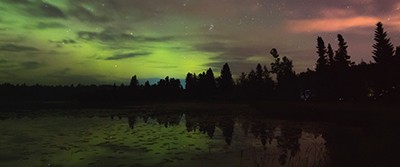Night Lights: Scientists Learn More About STEVE

By Kevin Ritchart
What’s the deal with STEVE?
Thanks to the collection and analysis of satellite data, scientists are now closer than ever to explaining STEVE, a reddish-purple band of light that appears in the night sky. STEVE, short for Strong Thermal Emission Velocity Enhancement, stretches from east to west and is sometimes accompanied by a row of vertical green stripes.
STEVE has been observed in the skies of the northern U.S., throughout Canada, and as far away as New Zealand and the United Kingdom.
Citizen scientists have been capturing images of STEVE for years, according to Don Hampton, a space physicist at the University of Alaska-Fairbanks. But only recently have scientists really begun to gather reliable data about how STEVE forms.
Scientists also may be able to predict the effects of weather on satellite signals. Heated air particles form STEVE’s purple ribbon, while electron showers from space create the green “picket fence” formation.
Interpreting Data
Yukitoshi Nishimura, a space physicist from Boston University, was part of a team that analyzed data from satellites that passed by STEVE in 2008 and again in 2016. The satellites observed particles and waves of energy surrounding the lights in the sky.
Nishimura and his team confirmed that a stream of electrically charged gas, known as plasma, is what creates the purple stripe. The plasma flows from east to west at approximately 3 miles per second, which creates friction that heats the particles in the air and results in some of them emitting a purple hue. Their findings were published earlier this year in Geophysical Research Letters.
Color Creation
Different chemicals in the air are responsible for the various colors that appear. Nishimura’s team isn’t exactly sure which plasma particles are the ones creating the purple stripe in the sky.
The vertical green lights are a little easier to explain. When electrons rain down from space, some of their energy is transferred to oxygen molecules in the sky. The excited oxygen molecules have a green glow.
This phenomenon is similar to other auroras that appear in the sky, like the famed northern lights. But it’s unusual for electrons to bombard the atmosphere at the latitudes where STEVE forms, which is closer to the equator than most other auroras.
While a great deal has been discovered recently, more analysis may help researchers learn even more about STEVE in the years to come.
Discussion Questions
- Have you ever seen a light formation like STEVE in the night sky? Where was it, and what time of day/year did you see it?
- What other factors do you think might contribute to the colors of the lights we can see in the sky?
Vocabulary
- Satellite
- Plasma
- Electrons
- Auroras

